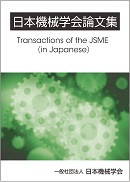85 巻, 875 号
選択された号の論文の26件中1~26を表示しています
- |<
- <
- 1
- >
- >|
材料力学,機械材料,材料加工
-
2019 年 85 巻 875 号 p. 18-00505
発行日: 2019年
公開日: 2019/07/25
[早期公開] 公開日: 2019/07/09PDF形式でダウンロード (1494K) -
2019 年 85 巻 875 号 p. 19-00053
発行日: 2019年
公開日: 2019/07/25
[早期公開] 公開日: 2019/07/09PDF形式でダウンロード (1422K)
流体工学,流体機械
-
2019 年 85 巻 875 号 p. 19-00072
発行日: 2019年
公開日: 2019/07/25
[早期公開] 公開日: 2019/06/27PDF形式でダウンロード (3286K)
熱工学,内燃機関,動力エネルギーシステム
-
2019 年 85 巻 875 号 p. 18-00399
発行日: 2019年
公開日: 2019/07/25
[早期公開] 公開日: 2019/06/27PDF形式でダウンロード (1455K) -
2019 年 85 巻 875 号 p. 18-00427
発行日: 2019年
公開日: 2019/07/25
[早期公開] 公開日: 2019/06/27PDF形式でダウンロード (1834K) -
2019 年 85 巻 875 号 p. 19-00068
発行日: 2019年
公開日: 2019/07/25
[早期公開] 公開日: 2019/07/04PDF形式でダウンロード (2602K)
機械力学,計測,自動制御,ロボティクス,メカトロニクス
-
2019 年 85 巻 875 号 p. 18-00355
発行日: 2019年
公開日: 2019/07/25
[早期公開] 公開日: 2019/07/05PDF形式でダウンロード (2722K) -
2019 年 85 巻 875 号 p. 18-00426
発行日: 2019年
公開日: 2019/07/25
[早期公開] 公開日: 2019/07/05PDF形式でダウンロード (2767K) -
2019 年 85 巻 875 号 p. 18-00453
発行日: 2019年
公開日: 2019/07/25
[早期公開] 公開日: 2019/07/05PDF形式でダウンロード (2207K) -
2019 年 85 巻 875 号 p. 18-00455
発行日: 2019年
公開日: 2019/07/25
[早期公開] 公開日: 2019/07/08PDF形式でダウンロード (2014K) -
2019 年 85 巻 875 号 p. 18-00462
発行日: 2019年
公開日: 2019/07/25
[早期公開] 公開日: 2019/07/08PDF形式でダウンロード (6083K) -
2019 年 85 巻 875 号 p. 19-00062
発行日: 2019年
公開日: 2019/07/25
[早期公開] 公開日: 2019/07/08PDF形式でダウンロード (2676K) -
2019 年 85 巻 875 号 p. 19-00064
発行日: 2019年
公開日: 2019/07/25
[早期公開] 公開日: 2019/06/13PDF形式でダウンロード (4416K) -
2019 年 85 巻 875 号 p. 19-00065
発行日: 2019年
公開日: 2019/07/25
[早期公開] 公開日: 2019/06/13PDF形式でダウンロード (9673K) -
2019 年 85 巻 875 号 p. 19-00069
発行日: 2019年
公開日: 2019/07/25
[早期公開] 公開日: 2019/06/13PDF形式でダウンロード (6629K) -
2019 年 85 巻 875 号 p. 19-00075
発行日: 2019年
公開日: 2019/07/25
[早期公開] 公開日: 2019/06/13PDF形式でダウンロード (19877K)
計算力学
-
2019 年 85 巻 875 号 p. 19-00086
発行日: 2019年
公開日: 2019/07/25
[早期公開] 公開日: 2019/06/11PDF形式でダウンロード (5173K) -
2019 年 85 巻 875 号 p. 19-00107
発行日: 2019年
公開日: 2019/07/25
[早期公開] 公開日: 2019/06/19PDF形式でダウンロード (3325K)
設計,機素・潤滑,情報・知能,製造,システム
-
2019 年 85 巻 875 号 p. 18-00491
発行日: 2019年
公開日: 2019/07/25
[早期公開] 公開日: 2019/06/21PDF形式でダウンロード (1754K) -
2019 年 85 巻 875 号 p. 19-00071
発行日: 2019年
公開日: 2019/07/25
[早期公開] 公開日: 2019/06/13PDF形式でダウンロード (2569K) -
2019 年 85 巻 875 号 p. 19-00109
発行日: 2019年
公開日: 2019/07/25
[早期公開] 公開日: 2019/06/28PDF形式でダウンロード (1476K) -
2019 年 85 巻 875 号 p. 19-00150
発行日: 2019年
公開日: 2019/07/25
[早期公開] 公開日: 2019/06/25PDF形式でダウンロード (3730K)
生体工学,医工学,スポーツ工学,人間工学
-
2019 年 85 巻 875 号 p. 19-00059
発行日: 2019年
公開日: 2019/07/25
[早期公開] 公開日: 2019/06/21PDF形式でダウンロード (2280K)
交通・物流
-
2019 年 85 巻 875 号 p. 18-00419
発行日: 2019年
公開日: 2019/07/25
[早期公開] 公開日: 2019/06/19PDF形式でダウンロード (1905K) -
2019 年 85 巻 875 号 p. 19-00003
発行日: 2019年
公開日: 2019/07/25
[早期公開] 公開日: 2019/06/19PDF形式でダウンロード (3059K) -
2019 年 85 巻 875 号 p. 19-00034
発行日: 2019年
公開日: 2019/07/25
[早期公開] 公開日: 2019/06/19PDF形式でダウンロード (4064K)
- |<
- <
- 1
- >
- >|
